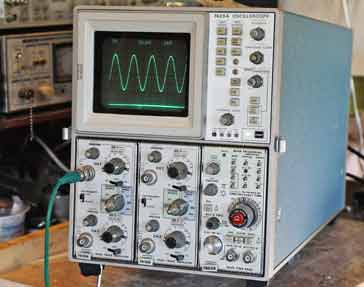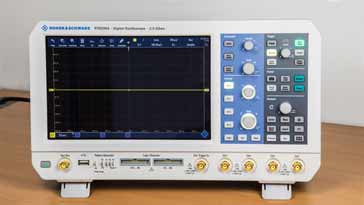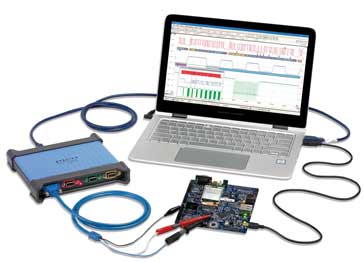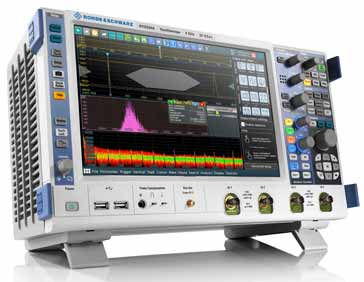Oscilloscope Types: Analog, Digital, USB, MSO, MDO . .
There are many different types of oscilloscope. Not only is there a distinction between analog and digital, but also storage, mixed signal and mixed domain types as well.
Scope types includes:
Analogue scope
Analogue storage scope
Digital phosphor scope
Digital scope
USB / PC scope
Mixed Signal Oscilloscope MSO
Sampling scope
Oscilloscope Tutorial Includes:
Oscilloscope basics
Oscilloscope types
Specifications
USB vs bench-top scope
How to use an oscilloscope
Scope triggering
Oscilloscope probes
Oscilloscope probe specifications
The oscilloscope is one of the most widely used test instruments for any form of electronic testing whether for RF design, general electronic circuit design, electronics manufacturing, service, repair and for use in many more applications.
Accordingly there are many types os oscilloscope available. Technology has moved forwards with analogue giving way to digital, and a variety of forms of oscilloscope to meet the ever increasing needs of electronic circuit design, electronics manufacture and many more areas.
When selecting a scope to buy, it is necessary to understand what the different types of oscilloscope are, and what they are able to test. Some types even combine an oscilloscope with logic testing, or spectrum analysis, providing much greater functionality for debugging circuits in digital design or RF design.
Video: differnet types of oscilloscope - differences and advantages
Common oscilloscope types
Whilst it is possible to categorise oscilloscopes in different ways, the main types of oscilloscope mentioned in the various manufacturers literature and talked about in books and online are detailed in the list below.
Analogue oscilloscope: This was the first type of oscilloscope to become popular. Based around the cathode ray tube, it was the mainstay of testing using oscilloscopes for very many years. Analogue techniques were used throughout.
The earliest analogue oscilloscopes were large and contained large numbers of vacuum tubes or thermionic valves. As technology moved forwards, new transistorised test instruments were introduced and these were much smaller. However they still needed to have significant depth to accommodate the cathode ray tube.
Truly analogue oscilloscopes did not offer the facilities which many test instruments offer today. capabilities like markers, accurate measurement of values, digital displays of the voltage of waveforms, very flexible trigger and much more. The older test equipment was very limited by today's standards, but these early test instruments still enabled electronic circuit design engineers to see the waveforms needed.
Read more about . . . . Analogue Oscilloscope.
Analogue storage scope: These test instruments were typically very large and expensive. This type of oscilloscope tended to be reserved for specialist use and it was not always easy to see the waveforms for any length of time. For long term storage of the waveform, it was necessary to take a photo of the screen, and special cameras were available for this!

Example of an analogue storage oscilloscope The key to the analogue storage scope was a special form of cathode ray tube that trapped the electrons from the electron beam, and enabled the screen to be illuminated by a charge to ensure the waveform that was stored to be seen.
The brighter the image on the screen, the shorter the length of time it could be clearly seen. This type of scope was expensive and the tubes were easy to burn out.
Read more about . . . . Analogue Storage Oscilloscope.
Digital oscilloscope: Digital technology has opened the door to significantly improved performance and the provision of a host of new capabilities within these test instruments.
Digital oscilloscopes now boast many capabilities that were not even dreamed of in the days of analogue technology, and top frequencies have now increased to the extent that they can be used for many RF design applications along with the general electronic circuit design and test applications that they have traditionally been used for.
There are various sub-types of digital oscilloscope - these tend to have been used after the introduction of digital technology, and now the term digital oscilloscope tends to be the only one used. The other terms are used in case they are encountered in various forms of literature:
- Digital Storage Oscilloscope, DSO: This was a term used after the initial introduction of digital oscilloscopes, indicating it had the memory to store waveforms and display them for a period of time. It was a real selling point for electronic circuit design engineers for whom an analogue storage scope would have been only a dream.
- Digital Phosphor Oscilloscope, DPO: This type of oscilloscope is a digital oscilloscope that uses a parallel processing architecture.
Read more about . . . . Digital Phosphor Oscilloscope.
- Digital Oscilloscope: This is the term that is generally used today and t is used to describe the type of oscilloscope that uses digital technology and digital signal processing technology at its core, although there is always some analogue input circuitry used.

A typical modern digital oscilloscope Today's scopes have a huge number of capabilities from the processing of the basic waveform to advanced triggering, and many scopes also have mixed signal capability as well as some scopes that provide the capability to display the spectrum of a waveform as well. With modern circuit architecture, the use of fast processing FPGAs and the like, the digital oscilloscopes of the current era contain far more capability than the early digital scopes of all varieties.
Read more about . . . . Digital Oscilloscope.
Digital Sampling Oscilloscope: Sampling oscilloscopes are used to capture exceedingly high frequency signals. This type of oscilloscope is used when analyzing very high-frequency signals. Signals that are repetitive signals and whose frequencies are higher than the oscilloscope's sampling rate.
For measuring repetitive signals, this type can have bandwidth and high-speed timing up to ten times greater than any real-time oscilloscope. Typically this type of scope starts with bandwidth levels of tens of gigahertz. Applications include analyzing high-speed serial buses, optical devices, and clock signals.
- Mixed signal oscilloscope, MSO: This type of oscilloscope is effectively the marrying up of am oscilloscope and a logic analyser. With many electronic circuit designs combining analogue electronic circuit design with digital circuitry as well, there is often a need to have some analogue oscilloscope input channels to look at waveform shapes, and then a number of logic analysis channels for looking at the digital state of various channels. IT is to meet this need, that mixed signal oscilloscopes were developed and introduced.
Typically the MSO has two or more fully capable scope channels and then a number of logic analysis channels, typically eight or sixteen.
Read more about . . . . Mixed signal oscilloscope, MSO.
- Mixed domain oscilloscope: This form of oscilloscope is a combination of an oscilloscope and a spectrum analyzer. Often when developing or repairing wireless communications systems it is necessary to have a scope and spectrum analyzer that are linked so that the effect of the digital or pre-wireless areas on the output RF signal can be seen.
This type of oscilloscope or analyzer is particularly helpful in enabling fault-finding of this RF designs that combine low frequency or digital circuitry with RF electronic circuit designs. The mixed domain oscilloscope is characterised by the separate RF input for spectrum analysis, and the normal oscilloscope inputs.
- USB oscilloscope: Using the power of a PC, this type of scope is able to provide the performance of many oscilloscopes but without the need for all the processing normally required. It connects to a PC using a USB link and uses the PC for its display etc.
Typically the better quality USB oscilloscopes will have an FPGA within the scope itself, and this undertakes all the signal processing. The computer can then be used for the human interface,, i.e control and display. This saves considerably on the cost of the oscilloscope without compromising on the electrical performance.

This means that a high performance scope can be made using a minimum of hardware, reducing the size and cost.
Read more about . . . . USB / PC based oscilloscope.
These are the major different types of oscilloscope. Some of more widely used than others, and of course, the analogue oscilloscope types are now used far less - mainly just legacy scopes that are available.

As can be seen, there are many different types of oscilloscope, each with their own characteristics. This means that different oscilloscope types will be applicable for different applications: RF design, general electronic circuit design, digital development, test, service, repair, etc. Choosing the correct type of oscilloscope will enable it to perform to its best and the user to gain the most from it.
 Written by Ian Poole .
Written by Ian Poole .
Experienced electronics engineer and author.
More Test Topics:
Data network analyzer
Digital Multimeter
Frequency counter
Oscilloscope
Signal generators
Spectrum analyzer
LCR meter
Dip meter, GDO
Logic analyzer
RF power meter
RF signal generator
Logic probe
PAT testing & testers
Time domain reflectometer
Vector network analyzer
PXI
GPIB
Boundary scan / JTAG
Data acquisition
Return to Test menu . . .



